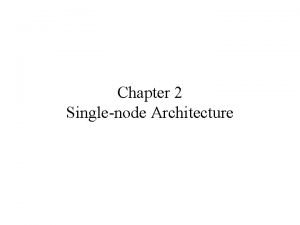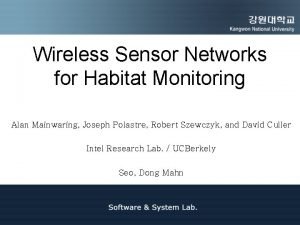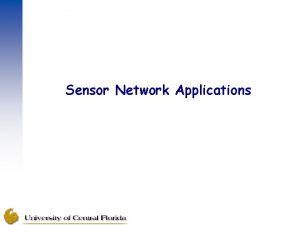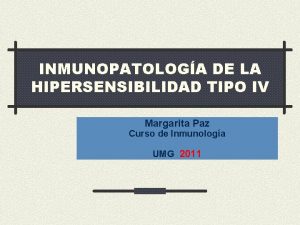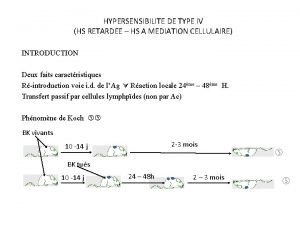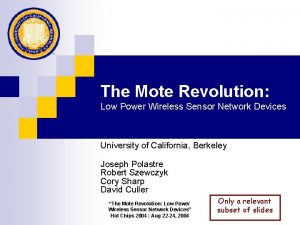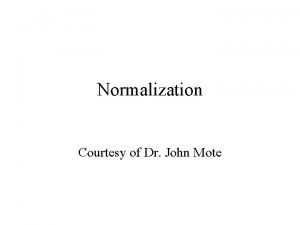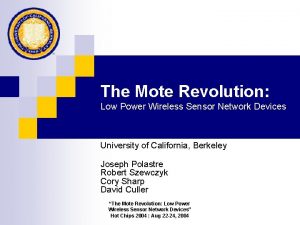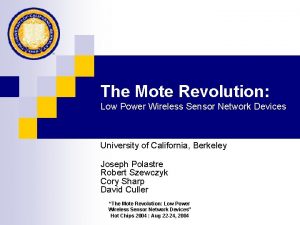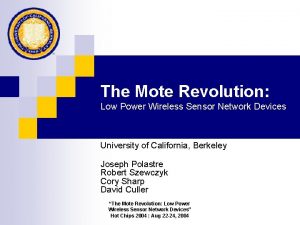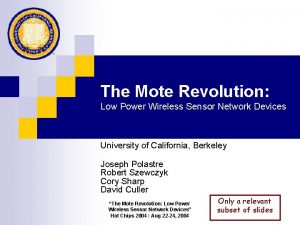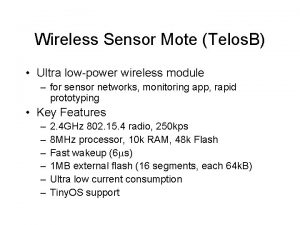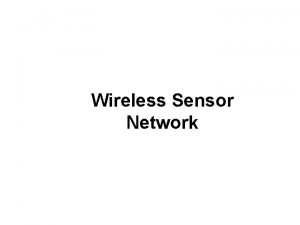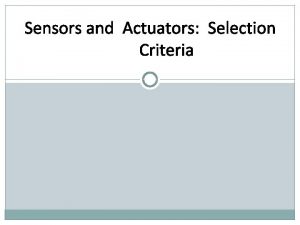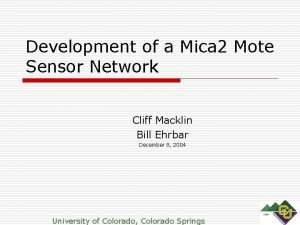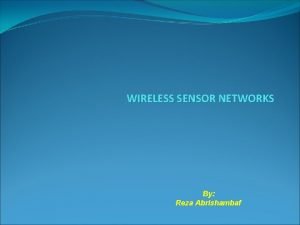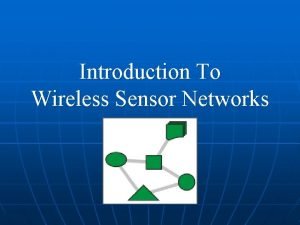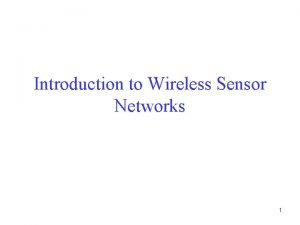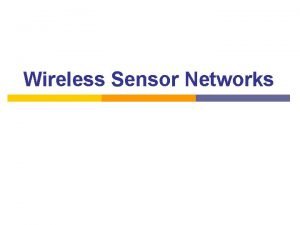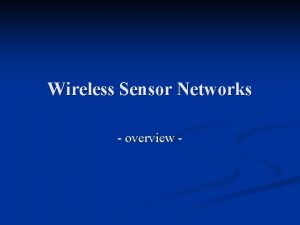The Mote Revolution Low Power Wireless Sensor Network
















- Slides: 16

The Mote Revolution: Low Power Wireless Sensor Network Devices University of California, Berkeley Joseph Polastre Robert Szewczyk Cory Sharp David Culler “The Mote Revolution: Low Power Wireless Sensor Network Devices” Hot Chips 2004 : Aug 22 -24, 2004 Only a relevant subset of slides

Outline Trends and Applications n Mote History and Evolution n Design Principles n Telos n “The Mote Revolution: Low Power Wireless Sensor Network Devices” Hot Chips 2004 : Aug 22 -24, 2004 2

Faster, Smaller, Numerous Moore’s Law ¨ n “Stuff” (transistors, etc) doubling every 1 -2 years Bell’s Law ¨ New computing class every 10 years Streaming Data to/from the Physical World log (people per computer) n year “The Mote Revolution: Low Power Wireless Sensor Network Devices” Hot Chips 2004 : Aug 22 -24, 2004 3

e n m o i i t s ife ci L e r P n& le & a o cy i e c t t n c S a e e t R & a n ty i L e n y l l t i o i p w b c s Lo Mo Dis Sam Den Applications n Environmental Monitoring Habitat Monitoring ¨ Integrated Biology ¨ Structural Monitoring ¨ n Interactive and Control Pursuer-Evader ¨ Intrusion Detection ¨ Automation ¨ “The Mote Revolution: Low Power Wireless Sensor Network Devices” Hot Chips 2004 : Aug 22 -24, 2004 4

Open Experimental Platform Services Networking Telos 4/04 Robust Low Power 250 kbps Easy to use Tiny. OS We. C 99 “Smart Rock” Rene 11/00 Dot 9/01 Small microcontroller 8 k. B code 512 B data Simple, low-power radio 10 kbps ASK Designed for experimentation EEPROM (32 KB) -sensor boards Simple sensors -power boards Demonstrate scale Mica 1/02 Mica 2 12/02 38. 4 kbps radio FSK NEST open exp. Platform 128 k. B code, 4 k. B data 40 kbps OOK/ASK radio 512 k. B Flash Spec 6/03 “Mote on a chip” Commercial Off The Shelf Components (COTS) “The Mote Revolution: Low Power Wireless Sensor Network Devices” Hot Chips 2004 : Aug 22 -24, 2004 5

Mote Evolution “The Mote Revolution: Low Power Wireless Sensor Network Devices” Hot Chips 2004 : Aug 22 -24, 2004 6

D/A A/D Microcontroller External Memory n n Digital I/O ports Radio Transceiver Analog I/O Ports Mote A very low cost low power computer Monitors one or more sensors A Radio Link to the outside world Are the building blocks of Wireless Sensor Networks (WSN) Sensor Nuwan Gajaweera Presentation 7

Low Power Operation n Efficient Hardware ¨ Integration and Isolation n Complementary functionality (DMA, USART, etc) ¨ Selectable Power States (Off, Sleep, Standby) ¨ Operate at low voltages and low current n Run to cut-off voltage of power source n Efficient Software ¨ Fine grained control of hardware ¨ Utilize wireless broadcast medium ¨ Aggregate “The Mote Revolution: Low Power Wireless Sensor Network Devices” Hot Chips 2004 : Aug 22 -24, 2004 8

Typical WSN Application Periodic ¨ ¨ ¨ Triggered Events ¨ ¨ Detection/Notification Infrequently occurs n n But… must be reported quickly and reliably Long Lifetime Months to Years without changing batteries ¨ Power management is the key to WSN success ¨ wakeup n Data Collection Network Maintenance Majority of operation Power n processing data acquisition communication sleep Time “The Mote Revolution: Low Power Wireless Sensor Network Devices” Hot Chips 2004 : Aug 22 -24, 2004 9

Design Principles n Key to Low Duty Cycle Operation: ¨ Sleep – majority of the time ¨ Wakeup – quickly start processing ¨ Active – minimize work & return to sleep “The Mote Revolution: Low Power Wireless Sensor Network Devices” Hot Chips 2004 : Aug 22 -24, 2004 10

Sleep n Majority of time, node is asleep ¨ >99% n Minimize sleep current through ¨ Isolating and shutting down ¨ Using low power hardware n Need RAM retention n individual circuits Run auxiliary hardware components from low speed oscillators (typically 32 k. Hz) ¨ Perform ADC conversions, DMA transfers, and bus operations while microcontroller core is stopped “The Mote Revolution: Low Power Wireless Sensor Network Devices” Hot Chips 2004 : Aug 22 -24, 2004 11

Telos Platform n A new platform for low power research ¨ n IEEE 802. 15. 4 ¨ USB ¨ Monitoring applications: n n n Environmental Building Tracking n Long lifetime, low power, low cost n Built from application experiences and low duty cycle design principles n Robustness ¨ ¨ ¨ IEEE 802. 15. 4 Zig. Bee CC 2420 radio ¨ Frame-based ¨ 250 kbps ¨ 2. 4 GHz ISM band ¨ n n Standards Based TI MSP 430 ¨ Integrated antenna Integrated sensors Soldered connections Ultra low power n n n 1. 6 m. A sleep 460 m. A active 1. 8 V operation Open embedded platform with open source tools, operating system (Tiny. OS), and designs. “The Mote Revolution: Low Power Wireless Sensor Network Devices” Hot Chips 2004 : Aug 22 -24, 2004 12

Minimize Power Consumption n Compare to Mica. Z: a Mica 2 mote with AVR mcu and 802. 15. 4 radio n Sleep ¨ ¨ ¨ n Wakeup ¨ ¨ ¨ n Majority of the time Telos: 2. 4 m. A Mica. Z: 30 m. A As quickly as possible to process and return to sleep Telos: 290 ns typical, 6 ms max Mica. Z: 60 ms max internal oscillator, 4 ms external Active ¨ ¨ ¨ Get your work done and get back to sleep Telos: 4 -8 MHz 16 -bit Mica. Z: 8 MHz 8 -bit “The Mote Revolution: Low Power Wireless Sensor Network Devices” Hot Chips 2004 : Aug 22 -24, 2004 13

CC 2420 Radio IEEE 802. 15. 4 Compliant n CC 2420 ¨ Fast data rate, robust signal n n ¨ Low Voltage Operation n ¨ 250 kbps : 2 Mchip/s : DSSS 2. 4 GHz : Offset QPSK : 5 MHz 16 channels in 802. 15. 4 -94 d. Bm sensitivity 1. 8 V minimum supply Software Assistance for Low Power Microcontrollers n n 128 byte TX/RX buffers for full packet support Automatic address decoding and automatic acknowledgements Hardware encryption/authentication Link quality indicator (assist software link estimation) ¨ samples error rate of first 8 chips of packet (8 chips/bit) “The Mote Revolution: Low Power Wireless Sensor Network Devices” Hot Chips 2004 : Aug 22 -24, 2004 14

Power Calculation Comparison Design for low power n Mica 2 (AVR) ¨ ¨ ¨ n 0. 2 ms wakeup 30 m. W sleep 33 m. W active 21 m. W radio 19 kbps 2. 5 V min n Mica. Z (AVR) ¨ ¨ ¨ 2/3 of AA capacity 0. 2 ms wakeup 30 m. W sleep 33 m. W active 45 m. W radio 250 kbps 2. 5 V min n n Telos (TI MSP) ¨ ¨ ¨ 0. 006 ms wakeup 2 m. W sleep 3 m. W active 45 m. W radio 250 kbps 1. 8 V min 2/3 of AA capacity n 8/8 of AA capacity Supporting mesh networking with a pair of AA batteries reporting data once every 3 minutes using synchronization (<1% duty cycle) 453 days 328 days 945 days “The Mote Revolution: Low Power Wireless Sensor Network Devices” Hot Chips 2004 : Aug 22 -24, 2004 15

Sensors n Integrated Sensors ¨ Sensirion SHT 11 n n n ¨ n Humidity (3. 5%) Temperature (0. 5 o. C) Digital sensor n n Total solar light Silicon diode 6 ADC channels 4 digital I/O Existing sensor boards n Photosynthetically active light Silicon diode Hamamatsu S 1337 -BQ Expansion ¨ ¨ ¨ Hamamatsu S 1087 n ¨ n n n Magnetometer Ultrasound Accelerometer 4 PIR sensors Microphone Buzzer acoustic mag ultrasound dot “The Mote Revolution: Low Power Wireless Sensor Network Devices” Hot Chips 2004 : Aug 22 -24, 2004 16
 Telecommunications the internet and wireless technology
Telecommunications the internet and wireless technology Wireless sensor network protocols
Wireless sensor network protocols Wireless sensor network ppt
Wireless sensor network ppt Single node architecture in wsn
Single node architecture in wsn Alan mainwaring
Alan mainwaring Forest geove
Forest geove Sensor wireless inc
Sensor wireless inc Wireless sensor networks for habitat monitoring
Wireless sensor networks for habitat monitoring Cellular digital packet data
Cellular digital packet data Sip möte skola
Sip möte skola Sip möte äldre
Sip möte äldre Poema de amor boa noite
Poema de amor boa noite Reaccion de jones mote
Reaccion de jones mote Hypersensibilité de jones mote
Hypersensibilité de jones mote Mica mote
Mica mote Sip möte vuxen
Sip möte vuxen John mote
John mote



